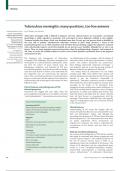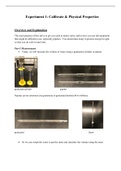Review
Tuberculous meningitis: many questions, too few answers
Lancet Neurol 2005; 4: 160–70 Guy E Thwaites, Tran Tinh Hien
Centre for Tropical Medicine,
Nuffield Department of Clinical Tuberculous meningitis (TM) is difficult to diagnose and treat; clinical features are non-specific, conventional
Medicine, Oxford University,
UK (G E Thwaites PhD);
bacteriology is widely regarded as insensitive, and assessment of newer diagnostic methods is not complete.
and Oxford University Treatment includes four drugs, which were developed more than 30 years ago, and prevents death or disability in
Clinical Research Unit less than half of patients. Mycobacterium tuberculosis resistant to these drugs threatens a return to the
(G E Thwaites PhD), Hospital for prechemotherapeutic era in which all patients with TM died. Research findings suggest that adjunctive treatment
Tropical Diseases, Ho Chi Minh
City, Vietnam (T T Hien MD)
with corticosteroids improve survival but probably do not prevent severe disability, although how or why is not
known. There are many important unanswered questions about the pathophysiology, diagnosis, and treatment of
Correspondence to:
Dr Guy Thwaites, Brighton and TM. Here we review the available evidence to answer some of these questions, particularly those on the diagnosis
Sussex University Hospital, and treatment of TM.
Department of Infectious
Diseases and Microbiology,
Eastern Road, Brighton, Sussex,
The diagnosis and management of tuberculous “an inflammation of the meninges, with the deposit of
BN2 5BE, UK meningitis (TM) challenges physicians throughout the tubercular matter in the form of granulations, or cheesy
guy.thwaites@btinternet.com world (panel 1). Unlike pulmonary tuberculosis, which matter”. The author’s conclusion was controversial:
has been the subject of many clinical trials, the these findings represented “tubercular meningitis”, a
pathogenesis, diagnosis, and treatment of TM have new diagnosis, and one to join the growing number of
received little attention. How the disease kills or disables diseases marked by the presence of “tubercles”.
more than half of those it infects is not understood; the The unitary theory of tuberculosis was not widely
best diagnostic tests are controversial; the optimum accepted until 1882, when Robert Koch stained and
choice, dose, and treatment duration of antituberculosis cultured Mycobacterium tuberculosis for the first time and
drugs are not known; and the outcome from adjunctive showed it was the bacterium transmitted in
corticosteroids and neurosurgical intervention has been tuberculosis.2 Thereafter, controversy turned to whether
difficult to study. TM resulted from direct haematogenous invasion of the
meninges by the bacilli, or by inoculation from
Clinical features and pathogenesis of TM contiguous lesions resulting from earlier bacillaemia. In
Historical perspective 1933, Rich and McCordock3 reported a series of elegant
Controversy has dogged TM since 1836, when The experiments in rabbits and children post-mortem; they
Lancet published a description of six children with fatal found the disease developed after the release of bacilli
“acute hydrocephalus”.1 Assessment post-mortem found from old focal lesions in communication with the
meninges. These lesions, called Rich foci, were typically
subpial or subependymal and most commonly situated
Panel 1: TM in clinical practice
in the sylvian fissure.3
Associated with TM
Recent exposure to tuberculosis (especially in children) Clinical features
Evidence of tuberculosis elsewhere (especially miliary Understanding of the events that happen after the
tuberculosis on chest radiograph) release of bacilli from Rich foci has advanced little since
HIV infection Rich and McCordock’s studies, and although the
presenting clinical features of TM have been described
Diagnosis
extensively (panel 2)4–9 the mechanisms that cause them
Acute
are poorly understood. These mechanisms are
Meticulous microscopy (and then culture) of ⭓5 ml of CSF
important for clinicians who need to understand the
After treatment commencement consequences of the disease, and may lead to new
PCR of CSF treatments.
Treatment
First 2 months Molecular and cellular pathogenesis
Four drugs: isoniazid, rifampicin, pyrazinamide and either An overview of the pathogenesis of TM and the variables
streptomycin, or ethambutol that might be associated with disease progression and
outcome is given in figure 1. The conflicting evidence on
Next 7–10 months
the role of tumour necrosis factor ␣ (TNF ␣) in
Isoniazid and rifampicin
pathogenesis shows the complexity of this process. The
Patients without HIV release of M tuberculosis into the subarachnoid space
Give dexamethasone, regardless of patient’s age or disease results in a local T-lymphocyte-dependent response,
severity characterised macroscopically as caseating granulo-
matous inflammation.10 In pulmonary tuberculosis,
160 http://neurology.thelancet.com Vol 4 March 2005
, Review
glucose ratio. However, total CSF white-cell count can be
Panel 2: TM symptoms on presentation4–9 normal in those with TM and depressed cell-mediated
immunity, such as the elderly and people with HIV;19,20
Symptom (proportion of patients affected)
low counts have been associated with poor outcome.15
Headache (50–80%)
Neutrophils can dominate, especially early in the
Fever (60–95%)
disease,21 and high proportions of neutrophils in the cell
Vomiting (30–60%)
count have been associated with an increased likelihood
Photophobia (5–10%)
of a bacteriological diagnosis and improved survival.
Anorexia (60–80%)
Hence, neutrophils could have a role in pathogenesis.15,22
Clinical sign (proportion of patients affected) The kinetics of the lymphocyte response are probably
Neck stiffness (40–80%) also important, particularly the roles of different
Confusion (10–30%) lymphocyte subsets,23 but more data on these cells are
Coma (30–60%) needed.
Any cranial nerve palsy (30–50%)
Cranial nerve III palsy (5–15%) Pathological and clinical consequences of infection
Cranial nerve VI palsy (30–40%) The macroscopic consequences of infection have been
Cranial nerve VII palsy (10–20%) researched post mortem and, more recently, through CT
Hemiparesis (10–20%) and MRI (figure 2) of the brain. Neurological
Paraparesis (5–10%) abnormalities occur with the development of an
Seizures (children: 50%; adults: 5%) inflammatory exudate that affects mostly the sylvian
fissures, basal cisterns, brainstem, and cerebellum.10
CSF (proportion or range)
Three processes cause most of the common neurological
Appearance (80–90% clear)
deficits: the adhesive exudate can obstruct CSF causing
Opening pressure (50% ⬎25 cm H20)
hydrocephalus and compromise efferent cranial nerves;
Total leucocyte count (5–1000⫻103/ml)
granulomas can coalesce to form tuberculomas (or an
Neutrophils (10–70%)
abscess in patients with uncharacteristic disease) which,
Lymphocyte (30–90%)
depending on their location, cause diverse clinical
Protein (45–250 mg/dL)*
consequences; and an obliterative vasculitis can cause
Lactate (5–10 mmol/L)
infarction and stroke syndromes.10 The severity of these
CSF glucose to blood glucose ratio (⬍0·5 in 95%)
complications may be dependent on the intracerebral
*CSF protein can be ⬎1000 mg/dL in patients with spinal block inflammatory response and strongly predicts outcome.15
Indeed, the severity of TM at presentation is classified
into three grades according to the patient’s Glasgow
TNF ␣ is thought to be crucial for granuloma coma score and the presence or absence of focal
formation,11 but is also cited as a main factor in host- neurological signs (panel 3),24 variables shown to be
mediated destruction of infected tissue.12 Studies of strongly predictive of death.26
pyogenic bacterial meningitis showed CSF Unusual clinical and pathological features of TM have
concentrations of TNF ␣ correlated with disease been well described in previous research papers and can
severity13 and study of rabbit models of TM found high cause diagnostic uncertainty.27,28 Movement disorders
CSF concentrations were associated with a worse can present after basal ganglia infarction; tremor is the
outcome,14 although TNF ␣ concentrations have not most common, but chorea, ballismus, and myoclonus
been correlated with disease severity or outcome in are all reported.29 Less common, and more controversial,
human beings.15 Treatment with antibiotics and than patients who present with movement disorders are
thalidomide, an anti TNF ␣ drug, improved survival and those who present with evidence of diffuse cerebral
neurological outcome in rabbits16 and suggested a novel involvement but without clinical or CSF signs of
therapeutic approach in people. Preliminary research meningitis. Dastur and Udani30 were the first to describe
found that thalidomide was safe and well-tolerated17 and this variant of cerebral tuberculosis, which they called
led to a controlled trial to assess the efficacy of adjunctive “tuberculous encephalopathy”, in Indian children with
thalidomide in children with TM. Sadly, this trial was disseminated tuberculosis. These children had a diffuse
stopped early because there were many adverse events in cerebral disorder with coma, convulsions, involuntary
the thalidomide arm and there did not seem to be any movements, and pyramidal signs but with normal CSF
benefit from treatment.18 measurements. Dastur31 has argued subsequently that
The numbers and types of white cells in the CSF help the pathogenesis of tuberculous encephalopathy may
differentiate TM from other meningitides, but little is differ from TM: post-mortem assessment of those with
known of their role in disease pathogenesis. Typically tuberculous encephalopathy found diffuse cerebral
the CSF shows a high CSF white-cell count, which is oedema, demyelination, and sometimes haemorrhage—
predominantly lymphocytic, with a high protein and low features that may be more typical of a post-infectious
http://neurology.thelancet.com Vol 4 March 2005 161





